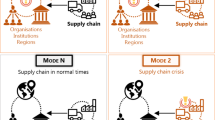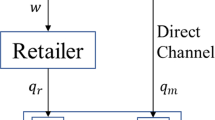Abstract
A multi-product two echelon supply chain within a newsvendor framework is studied, in which semi-finished products are produced by a supplier and customized according to specific customer orders. The focus of this paper is to investigate a situation where the manufacturer wishes to determine the fraction of production performed by the supplier, its optimal semi-finished product order size, and price for each product type. In order to make the problem more practical, capacity and budget constraints are considered. The computability of the presented model is explored by a numerical example with Poisson arrival demands.









Similar content being viewed by others
References
Andreev, O.D., Koleva, N.V.: Opportunities for Applying Customer Order Decoupling Point Approach. The European Entrepreneurship, How Entrepreneurs (Should) Act in Global Business Environment (2013)
Andreev, O., Panayotova, T.: Customer order decoupling point issues in a project environment. Serbian J. Manag. 8(2), 243–253 (2013)
Boyaci, T., Ray, S.: Product differentiation and capacity cost interaction in time and price sensitive markets. Manuf. Serv. Oper. Manag. 5(1), 18–36 (2003)
Carr, S., Duenyas, I.: Optimal admission control and sequencing in a make-to-stock/make-to-order production system. Oper. Res. 48(5), 709–720 (2000)
Dada, M., Hu, Q.: Financing newsvendor inventory. Oper. Res. Lett. 36(5), 569–573 (2008)
Federgruen, A., Katalan, Z.: Impact of adding a make-toorder item to a make-to-stock production system. Manag. Sci. 45(7), 980–994 (1999)
Feitzinger, E., Lee, H.: Mass customization at Hewlett Packard: the power of postponement. Harv. Bus. Rev. 75, 116–121 (1997)
Fisher, M., Ramdas, K., Ulrich, K.: Component sharing in the management of product variety: A study of automotive braking systems. Manag. Sci. 45(3), 297–315 (1999)
Geunes, J.P., Ramasesh, R.V., Hayya, J.C.: Adapting the newsvendor model for infinite-horizon inventory systems. Int. J. Prod. Econ. 72(3), 237–250 (2001)
Gupta, D., Benjaafar, S.: Make-to-order, make-to-stock, or delay product differentiation? A common framework for modeling and analysis. IIE Trans. 36(6), 529–546 (2004)
Hadley, G., Whitin, T.M.: Analysis of Inventory Syst. Prentice Hall, New Jersey (1963)
Harrison, J.M., Van Mieghem, J.A.: Multi-resource investment strategies: operational hedging under demand uncertainty. Eur. J. Oper. Res. 113(1), 17–29 (1999)
Hoekstra, S., Romme, J.: Integral Logistic Structures: Developing Customer-Oriented Goods Flow. Industrial Press Inc, Norwalk (1992)
Jewkes, E.M., Alfa, A.S.: A queueing model of delayed product differentiation. Eur. J. Oper. Res. 199(3), 734–743 (2009)
Keren, B.: The single-period inventory problem: extension to random yield from the perspective of the supply chain. Omega 37(4), 801–810 (2009)
Khouja, M.: A note on the newsboy problem with an emergency supply option. J. Oper. Res. Soc. 47(12), 1530–1534 (1996)
Lee, H.L.: Effective inventory and service management through product and process redesign. Oper. Res. 44(1), 151–159 (1996)
Lee, H.L., Tang, C.S.: Modelling the costs and benefits of delayed product differentiation. Manag. Sci. 43(1), 40–53 (1997)
Liu, W., Mo, Y., Yang, Y., Ye, Z.: Decision model of customer order decoupling point on multiple customer demands in logistics service supply chain. Prod. Plan. Control 26(3), 178–202 (2015)
Lodree, E.J., Kim, Y., Jang, W.: Time and quantity dependent waiting costs in a newsvendor problem with backlogged shortages. Math. Comput. Model. 47(1), 60–71 (2008)
Mason-Jones, R., Naylor, B., Towill, D.R.: Engineering the leagile supply chain. Int. J. Agile Manag. Syst. 2(1), 54–61 (2001)
Niederhoff, J.A.: Using separable programming to solve the multi-product multiple ex-ante constraint newsvendor problem and extensions. Eur. J. Oper. Res. 176(2), 941–955 (2007)
Olhager, J.: Strategic positioning of the order penetration point. Int. J. Prod. Econ. 85(3), 319–329 (2003)
Olhager, J., Östlund, B.: An integrated push-pull manufacturing strategy. Eur. J. Oper. Res. 45(2), 135–142 (1990)
Pagh, J.D., Cooper, M.C.: Supply chain postponement and speculation strategies: how to choose the right strategy. J. Bus. Logist. 19, 13–34 (1998)
Pagh, J.D., Cooper, M.C.: Supply chain postponement and speculation strategies: how to choose the right strategy. J. Bus. Logist. 19, 13–34 (1998)
Parlar, M., Wang, D.: Diversification under yield randomness in inventory models. Eur J. Oper. Res. 66(1), 52–64 (1993)
Pine, B.J.: Mass Customization: The New Frontier in Business Competition. Harvard Business Press, Brighton (1993)
Sahin, E., Dallery, Y.: Assessing the impact of inventory inaccuracies within a newsvendor framework. Eur. J. Oper. Res. 197(3), 1108–1118 (2009)
Sharman, G.: The rediscovery of logistics. Harv. Bus. Rev. 62(5), 71–79 (1984)
Shidpour, H., Da Cunha, C., Bernard, A.: Analyzing single and multiple customer order decoupling point positioning based on customer value: a multi-objective approach. Proced. CIRP 17, 669–674 (2014)
Silver, E., Pyke, D.F., Peterson, R.: Inventory Management and Production Planning and Scheduling. Wiley, New York (1998)
Teimoury, E., Modarres, M., Khondabi, I.G., Fathi, M.: A queuing approach for making decisions about order penetration point in multiechelon supply chains. Int. J. Adv. Manuf. Technol. 63(1–4), 359–371 (2012)
Tsay, A.A., Agrawal, N.: Channel dynamics under price and service competition. Manuf. Serv. Oper. Manag. 2(4), 372–391 (2000)
Van Donk, D.P.: Make to stock or make to order: the decoupling point in the food processing industries. Int. J. Prod. Econ. 69(3), 297–306 (2001)
Mieghem, J.A.V., Rudi, N.: Newsvendor networks: inventory management and capacity investment with discretionary activities. Manuf. Serv. Oper. Manag. 4(4), 313–335 (2002)
Vanteddu, G., Chinnam, R.B.: Supply chain focus dependent sensitivity of the point of product differentiation. Int. J. Prod. Res. 52(17), 4984–5001 (2014)
Yang, K., Wang, E.: Optimal control of decoupling point with deteriorating items. J. Ind. Eng. Manag. 7(5), 1368–1384 (2014)
Yano, C.A., Lee, H.L.: Lot sizing with random yields: a review. Oper. Res. 43(2), 311–334 (1995)
Zhou, L., Li, M.: Location of customer order decoupling point in the supply chain of deteriorated food based on dynamic model. Adv. J. Food Sci. Technol. 6(2), 254–258 (2014)
Author information
Authors and Affiliations
Corresponding author
Appendices
Appendix 1
As \(\lambda_{i}\) denotes the demand rate for product \(i\), it is obvious that it only takes the nonnegative values. By assuming \(\lambda_{i} \ge 0\), we will have (13) and (14):
If we consider \(\frac{{(\beta_{P} + \gamma_{P} )}}{{\gamma_{P} }} = a_{1}\) and \(\frac{{\beta_{K} K_{i} - \gamma_{K}^{{}} (K_{j} - K_{i} ) - \alpha_{i} }}{{\gamma_{P} }} = b_{1}\), we can write (13) as (14):
By the same assumption for \(\lambda_{j} \ge 0\), we will have (16) and (17):
If we consider \(\frac{{(\beta_{P} + \gamma_{P} )}}{{\gamma_{P} }} = a_{2}\) and \(\frac{{\beta_{K} K_{j} - \gamma_{K}^{{}} (K_{i} - K_{j} ) - \alpha_{j} }}{{\gamma_{P} }} = b_{2}\), we can write (17) as (18):
By replacing (18) in (15), we will find the upper bound of \(P_{i}\) as (19):
By using the same procedure and replacing (18) in (15), we will find the upper bound of \(P_{j}\) as (20):
Appendix 2
In the sensitivity analysis section, both completion percentages are assumed to be equal and increase simultaneously, so we can assume \(\theta_{1} = \theta_{2} = \theta\), and for the first product, we have (21):
By inserting \(K_{1} (\theta_{1} ) = 1 - \theta\) and \(K_{2} (\theta_{2} ) = 1.2(1 - \theta )\) to 21, we will have (22):
Considering \(\beta = 14 - 0.15P_{1} + 0.1(P_{2} - P_{1} )\) as a constant value, we will have (23):
(23) shows that \(\lambda_{1}\) is an increasing function of \(\theta\). The same procedure can be applied for \(\lambda_{2}\).
Rights and permissions
About this article
Cite this article
Ghalehkhondabi, I., Ardjmand, E. & Weckman, G. Integrated decision making model for pricing and locating the customer order decoupling point of a newsvendor supply chain. OPSEARCH 54, 417–439 (2017). https://doi.org/10.1007/s12597-016-0286-1
Accepted:
Published:
Issue Date:
DOI: https://doi.org/10.1007/s12597-016-0286-1




